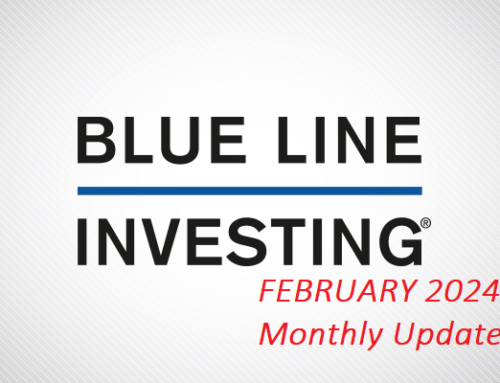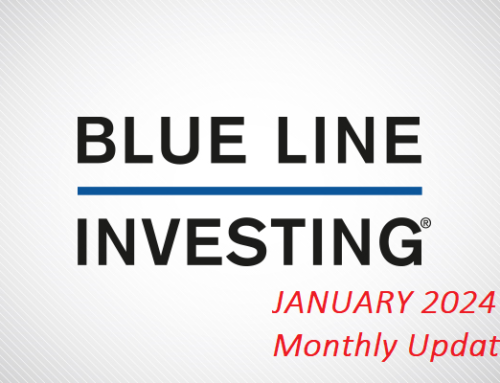
Commentary:
The US stock market, as measured by the S&P 500 Index² (S&P) finished the month of September closing 6.00% above the Blue Line, down from 6.81% at the end of August. With the S&P remaining above the Blue Line we continue to categorize the primary trend as Positive.
We consistently review a universe of over 500 Exchange-Traded Funds (ETFs) to both search for new potential investment opportunities as well as to monitor the primary trend for several asset classes, which include: US stocks, International stocks, Commodities, Currencies, and Bonds (Fixed Income). We find it interesting that currently, and speaking in general, the US stock market appears to be in a positive primary trend; International stocks and Bonds appear to be in neutral primary trends; and Commodities and many Currencies are in negative primary trends. In other words, it appears capital continues to flow into the US markets at the expense of other financial markets, even those that may be considered less expensive. Investors who claim the US stock markets are “too expensive” might ask themselves a question – “Compared to what?”
History has taught us that “expensive” investments can continue to rise and become even more “expensive” for quite some time. And “cheap” investments can continue to suffer additional financial losses and become “cheaper” longer than expected. This is where we believe the “Blue Line” can be beneficial. It acts as a reference point to help determine the primary trend of an investment, when one can be identified, and when the trend may be changing. It helps remove personal bias and opinion to allow for more objective interpretation. If history continues to repeat, we believe the Blue Line will help inform us again when this positive primary trend in the US stock markets may be coming to an end…whenever that may be in the future.
Jeff Link
Disclaimers:
¹ Blue Line Investing (BLI) is an alternative to traditional wealth management. BLI uses a disciplined, rules-based investment process to seek investment opportunities, regardless of whether financial markets are rising or falling. Based on technical analysis research, the process applies trend-following along with observations of economic moving averages of the market and other technical indicators.
² The S&P 500 Index is one of the most commonly followed equity indices, and many consider it one of the best representations of the U.S. stock market, and a bellwether for the U.S. economy. It is comprised of 500 large companies having common stock listed on the NYSE or NASDAQ. The volatility (beta) of the account may be greater or less than the index. It is not possible to invest directly in this index.
The volatility (beta) of an account may be greater or less than that of an index. It is not possible to invest directly in an index. Technical analysis is a method of evaluating securities by analyzing statistics generated by market activity, such as past prices and volumes. Technical analysis attempts to predict a future stock price or direction based on market trends. The assumption is that the market follows discernible patterns and if these patterns can be identified then a prediction can be made. The risk is that markets may not always follow patterns. There are certain limitations to technical analysis research, such as the calculation results being impacted by changes in security price during periods of market volatility. Technical analysis is one of many indicators that may be used to analyze market data for investing purposes and should not be considered a guaranteed prediction of market activity. The opinions expressed are those of Blue Line Investing. The opinions referenced are as of the date of publication and are subject to change without notice. Blue Line Investing reserves the right to modify its current investment strategies based on changing market dynamics or client needs.
Past performance is not indicative of future results. This material is not financial advice or an offer to sell any product. The information contained herein should not be considered a recommendation to purchase or sell any particular security. This information is intended for educational purposes only. Forward looking statements cannot be guaranteed.
Advisory services offered through Gordon Asset Management, LLC (GAM). GAM is an SEC-registered investment adviser. Registration does not imply a certain level or skill or training. More information about the advisor, its investment strategies and objectives, is included in the firm’s Form ADV Part 2, which can be obtained, at no charge, by calling (866) 216-1920. The principle office of Gordon Asset Management, LLC is located at 1007 Slater Road, Suite 200, Durham, North Carolina, 27703.




